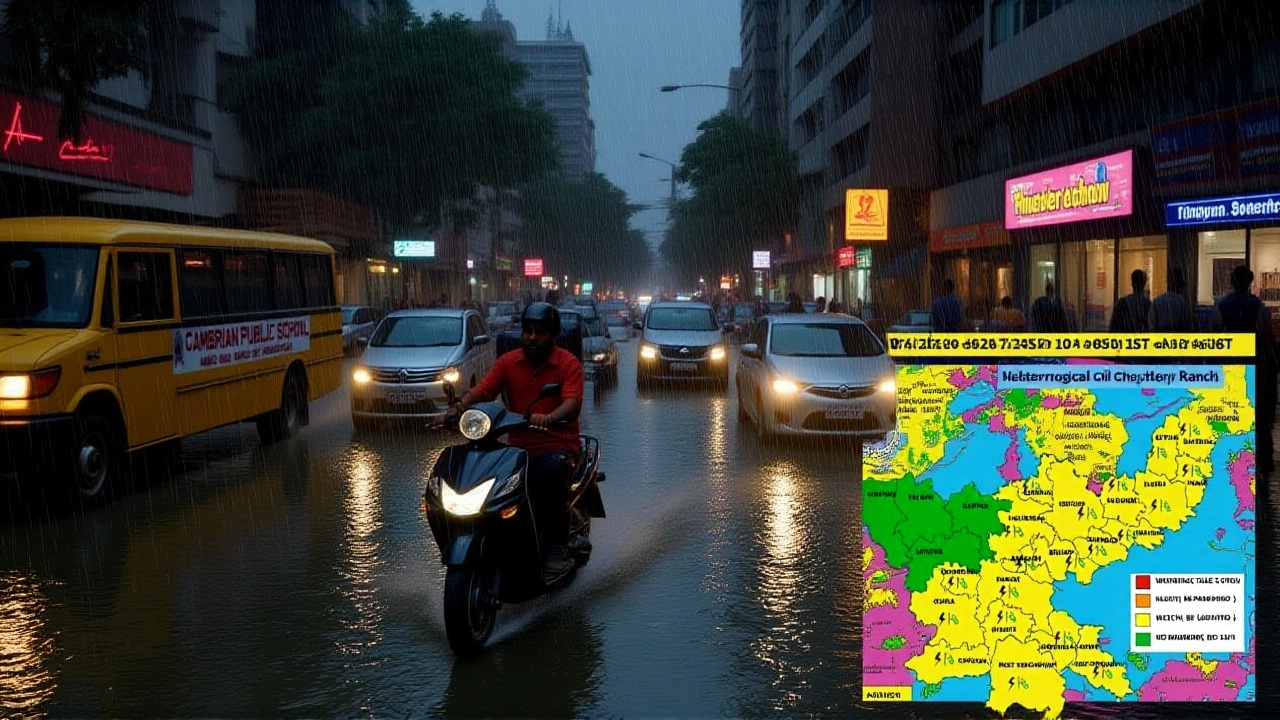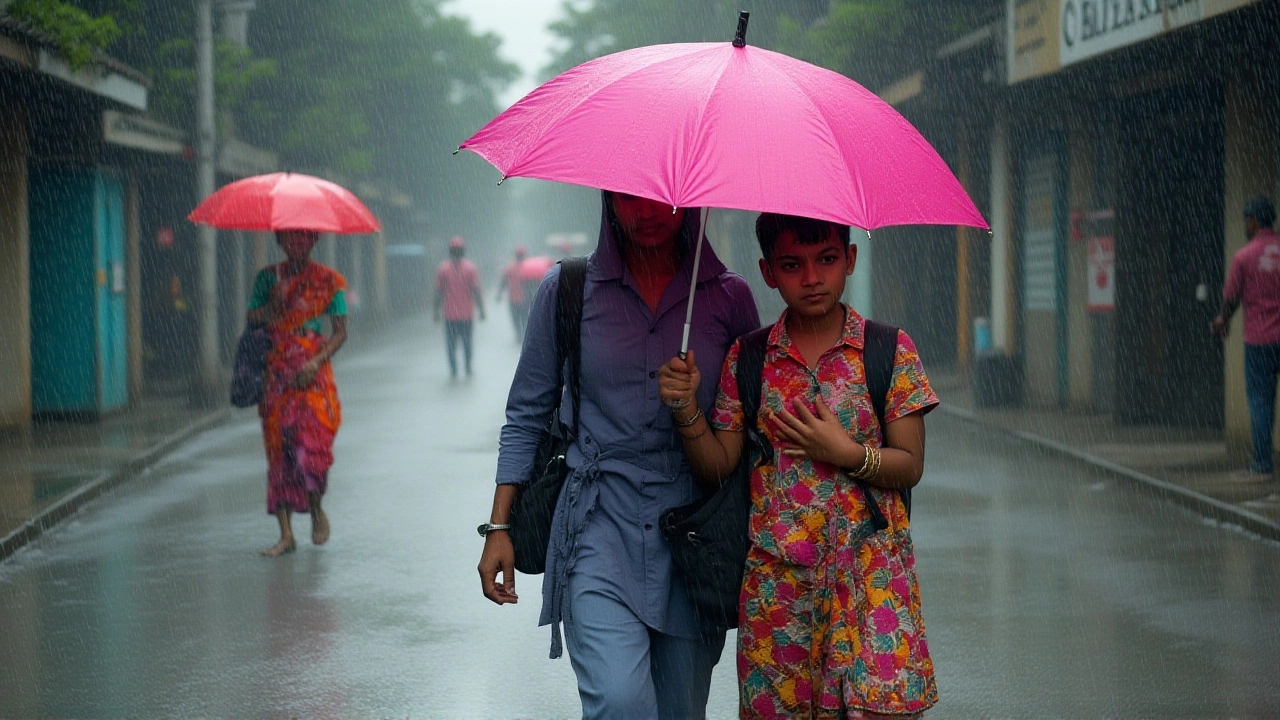When Indian Meteorological Department issued a yellow alert on October 1, 2025, residents of Jamshedpur (also known as Tatanagar) braced for a relentless stretch of rain that will last until October 8.
The alert, formally titled Daily Rainfall Alert for JharkhandJharkhand, India, warns of daily precipitation, strong winds of 30‑40 km/h, and thunderstorms on the 6th, 7th and 8th of October across most districts. A yellow alert has also been extended to Dumka, Godda, Sahibganj and Pakur.
What the IMD Alert Says
According to the department’s latest bulletin, Jamshedpur is expected to see rain once or twice each day, with total accumulation hovering around 0.4 mm in the past 24 hours. Day‑time temperatures have nudged up to 33.2 °C—just 0.7 °C above the seasonal norm—while night‑time lows sit at 24.4 °C, a shade below average. Humidity is stubbornly high, swinging between 69 % and 83 %.
The broader picture for Jharkhand is less rosy. The department forecasts heavy rainfall and gusty breezes persisting state‑wide, with the highest recorded precipitation this week at 185 mm in Bhawanathpur. Latehar district, meanwhile, logged the lowest night temperature across the state.
Day‑by‑Day Weather Snapshot
- Oct 5 (Saturday): Cloud cover from dawn, intermittent drizzle, 0.4 mm rain, 33.2 °C day, 24.4 °C night.
- Oct 6‑8: Thunderstorms expected, wind speeds 30‑40 km/h, rain likely each afternoon.
- Oct 9 onward: IMD says relief is uncertain; watch for updates.
These figures matter because they drive everything from school closures to traffic snarls. Already, schools in Jamshedpur have shifted to online classes for the week, and the municipal corporation has warned drivers about slick roads.
Impact on Daily Life and Local Economy
For a city that thrives on steel production and IT services, a wet spell can have a domino effect. The Tata Steel plant, one of Jamshedpur’s largest employers, reported a minor slowdown in outdoor loading operations on October 5 due to delayed shipments. Small traders in the city’s commercial hubs say footfall has dipped by roughly 12 % compared with the same weekday last month.
Farmers in surrounding rural blocks are watching the rainfall with a mix of relief and anxiety. While the water‑logged fields get a boost, the persistent drizzle hampers drying of harvested crops, raising concerns about post‑harvest losses.

Expert Views on the Prolonged Wet Spell
"This pattern is typical of a monsoon retreat phase, but the persistence of daily showers into early October is unusual for this part of the country," explains Dr. Anil Kumar, senior scientist at the Indian Meteorological Department. "We’re seeing a convergence of a western disturbance with residual monsoonal moisture, which explains the steady drizzle and the isolated thunderstorms."
Local health officials caution that prolonged humidity can aggravate respiratory conditions. "Patients with asthma should keep inhalers handy and avoid outdoor activity during peak rain periods," says Dr. Meera Singh, chief medical officer at Jamshedpur Regional Hospital.
What Residents Can Do Now
Authorities recommend a few practical steps:
- Keep windows and doors closed during thunderstorms to prevent water ingress.
- Store important documents in waterproof containers.
- Charge mobile devices and power banks ahead of possible power fluctuations.
- Avoid driving through flooded low‑lying roads; use higher routes when possible.
- Stay tuned to IMD updates via radio, TV and the department’s official app.
Community volunteers have already set up temporary shelters in schools for those displaced by minor flooding in Bhawanathpur. The local disaster response team is also distributing sandbags to neighborhoods most at risk.

Looking Ahead: When Might the Rain Let Up?
The IMD’s next bulletin, expected on October 9, will indicate whether the yellow alert will be downgraded to a green one. Meteorologists say the odds of a dry spell before mid‑October remain low, but a shift in wind patterns could finally coax the moisture out of the region.
For now, Jamshedpur residents are learning to live with the sound of steady rain—an unwelcome but familiar soundtrack to the city’s industrial rhythm.
Frequently Asked Questions
How will the yellow alert affect daily commuters in Jamshedpur?
Commuters should expect slower traffic due to slick roads and occasional waterlogging. Public transport may run on adjusted schedules, and drivers are advised to avoid low‑lying routes during peak rain periods.
What precautions are schools taking during the rain spell?
Most schools in Jamshedpur have shifted to online classes until the alert eases. Those that stay open have reinforced roof structures, placed sandbags around vulnerable entrances, and issued daily weather briefings to staff and students.
Will the continuous rain impact the steel production at Tata Steel?
Outdoor loading bays have seen minor delays, but the plant’s internal processes remain largely unaffected. However, prolonged humidity could increase maintenance needs for equipment exposed to the elements.
What health risks are associated with high humidity and rain?
High humidity can worsen asthma and other respiratory conditions. Residents are urged to keep indoor spaces well‑ventilated, use dehumidifiers if possible, and stay hydrated to mitigate heat‑related discomfort.
When is the next IMD update expected?
The Indian Meteorological Department releases updates every 24 hours. The next bulletin, scheduled for October 9, will indicate whether the yellow alert will be maintained, upgraded, or downgraded.



